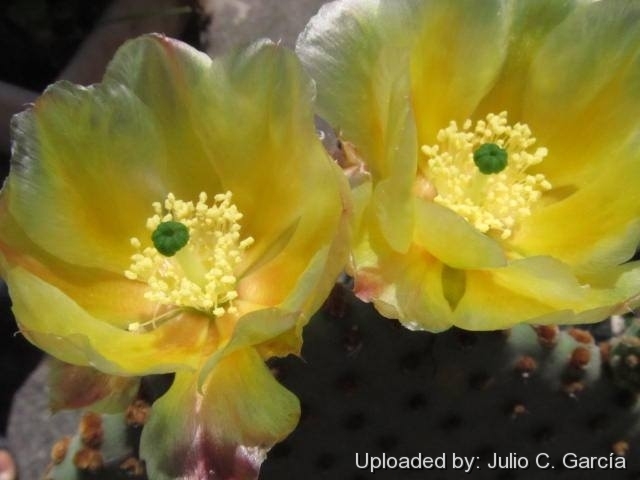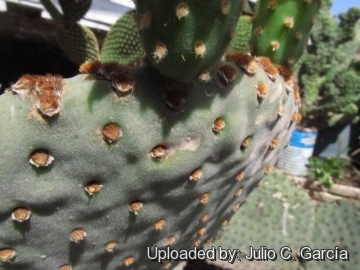Accepted Scientific Name: Opuntia rufida Engelm.
Syn. Cact. U. S. 42 (1856) emarks: preprint of Proc. Am. Acad. iii. (1857) 298. Engelm.

Opuntia microdasys subs. rufida (Opuntia rufida) Photo by: Julio C. García
Origin and Habitat: Opuntia rufida is relatively common in Texas (southern Presidio and Brewster counties, along and near the Rio Grande) and Adjacent Mexican states of Chihuahua, Coahuila, Durango and Zacatecas .
Altitude range: It occurs at elevations of 600-1300 metres above sea level.
Habitat and Ecology: Opuntia rufidaSN|15516]]SN|15516]] is common in desert habitats in xerophyllous scrub, in flats, south-facing cliffs, and on hillsides, often among dark, rough boulders. It grows on sandy or gravelly soils composes of both calcareous or volcanic material. The species is abundant throughout its range, and there are no major threats. A potential threat to species of the genus Opuntia is the invasion of the cactus moth Cactoblastis cactorum, which can exterminate populations completely.
Synonyms:
See all synonyms of Opuntia rufida
back
Accepted name in llifle Database:Opuntia rufida Engelm.Syn. Cact. U. S. 42 (1856) emarks: preprint of Proc. Am. Acad. iii. (1857) 298.Synonymy: 7
back
Common Names include:
ENGLISH: Blind Prickly Pear, Cactus red bunny ears, Cinnamon bunny ears, Cinnamon pear, Clock face cactus, Cow blinder, Blind Pricklypear
GERMAN (Deutsch): Fuchsrote, Fuchsrote Opuntie, Fuchsroter, Fuchsroter Feigenkaktus
SPANISH (Español): Nopal cegador, Nopalillo cegador, Nopal rojizo
Description: Opuntia rufidaSN|15506]]SN|15516]] (a.k.a. Opuntia microdasysSN|15506]]SN|15506]] subs. rufida) is a fairly large shrubby or tree like, blue-green prickly pear, with several branches and rarely with a somewhat definite trunk to ca 1.5 m high and 2.5 m wide. Spines are absent but the joints have copious evenly spaced areoles in which numerous reddish glochids are borne. The common names in English (blind prickly pear) and Spanish (nopal cegador) come from the belief that the glochids are loose and supposedly may fly into the air when the plants are shaken. The dislodged glochids may get into the eyes of animals and cause severe problems.
Derivation of specific name: The name of the species comes from the Latin “rufus”, = reddish, with obvious reference.
Stem: More or less erect, 20 to 150 cm high, with a somewhat definite trunk. Joints (cladodes) nearly orbicular, obovate or elliptical 10-18 cm long and (5-)7-20(-25) cm in diameter, 1-1.5 cm thick, velvety-tomentose, dull grayish green or bluish green.Branches are not easily disarticulating.
Leaves: Subulate, caducous, 4 to 6 cm long, green with reddish tips.
Areoles: Round, 3-3.2 mm in diameter, 5-20 mm apart, 8-13 per diagonal row on mid-stem segment, without spines but filled with a short white or bronze down and with numerous glochids. The glochids are brown or reddish ageing to grey and easily detached.
Spines: Absent.
Flowers: Pale yellow, becoming golden yellow to orange with age, usually from the areoles placed on the upper edge of the one year old cladodes, 4 to 6 (-7.5) cm long and in diameter. Tepals obovate, 2 to 2.5 cm long, the outer ones lanceolate, the inner ones obovate with almost truncated apex. Filaments greenish white or whitish, short, 1 cm long. Anthers: yellow to cream. Style colorless 1.5 cm long, thick, bulbous just above the base; stigma-lobes 5, deep green. Pericarpel vary globular, 1.5 cm. in diameter, with large areoles.
Blooming season: This cactus is expected to bloom in spring to early summer (in habitat March and into May or June). Flowers open in mid- to late morning, close at night time, and often do not reopen.
Fruit (berries): Globular, elliptical or obovate concave (umbilicate) at the apex, spine-less, reddish green to bright red at maturity, fleshy, slightly tuberculate, to (2-)2.5-3(-3.5) cm long, 1.5-2 cm in diameter with greenish pulp.
Similar species: This species seems much less common than Opuntia microdasysSN|15516]]SN|15506]], with which it is often confused.
Seeds: Tan or bronze coloured, irregularly discoid, 2-3 mm in diameter.
Subspecies, varieties, forms and cultivars of plants belonging to the Opuntia microdasys group
Bibliography: Major references and further lectures
1) James Cullen, Sabina G. Knees, H. Suzanne Cubey “The European Garden Flora Flowering Plants: A Manual for the Identification of Plants Cultivated in Europe, Both Out-of-Doors and Under Glass” Cambridge University Press, 11/Aug/2011
2) A. Michael Powell “Trees & Shrubs of the Trans-Pecos and Adjacent Areas” University of Texas Press, 05/Jul/2010
3) David R Hunt; Nigel P Taylor; Graham Charles; International Cactaceae Systematics Group. "The New Cactus Lexicon" dh books, 2006
4) Flora of North America Editorial Committee, e. “Magnoliophyta: Caryophyllidae” part 1. 4: i–xxiv, 1–559. In Fl. N. Amer.. Oxford University Press, New York. 2003.
5) Lyman David Benson “The Cacti of the United States and Canada” Stanford University Press, 1982
6) N. L. Britton, J. N. Rose: “The Cactaceae. Descriptions and Illustrations of Plants of the Cactus Family.” Vol I, The Carnegie Institution of Washington, Washington 1919
Edward Anderson “The Cactus family” Timber Press, Incorporated, 2001
7) Ulises Guzmán, Salvador Arias, Patricia Dávila, “Catálogo de cactáceas mexicanas” Universidad Nacional Autónoma de México, Mexico 2003
8) Urs Eggli, Leonard E. Newton: “Etymological Dictionary of Succulent Plant Names” Birkhäuser 2004
9) Curt Backeberg: "Die Cactaceae: Handbuch der Kakteenkunde" 2 Auflage. Band I, Gustav Fischer Verlag, Stuttgart New York 1982
10) Brian Loflin, Shirley Loflin “Texas Cacti: A Field Guide” Texas A&M University Press, 26/Oct/2009
11) Corral-Díaz, R., Goettsch, B.K., Heil, K. & Terry, M. 2013. Opuntia rufida. The IUCN Red List of Threatened Species. Version 2014.3. <www.iucnredlist.org>. Downloaded on 21 November 2014.
12) Anonymous. “List-Based Rec., Soil Conserv. Serv., U.S.D.A.” Database of the U.S.D.A., Beltsville. 1986.
13) Correll, D. S. & M. C. Johnston. “Man. Vasc. Pl. Texas” i–xv, 1–1881. The University of Texas at Dallas, Richardson.1970.
14) Véliz Pérez, M. E. “Cactáceas Guatemala” 1–129. Univ. de San Carlos de Guatemala, Guatemala. 2008
 Opuntia microdasys subs. rufida (Opuntia rufida) Photo by: Julio C. García
Opuntia microdasys subs. rufida (Opuntia rufida) Photo by: Julio C. GarcíaSend a photo of this plant.The gallery now contains thousands of pictures, however it is possible to do even more. We are, of course, seeking photos of species not yet shown in the gallery but not only that, we are also looking for better pictures than those already present.
Read More...











